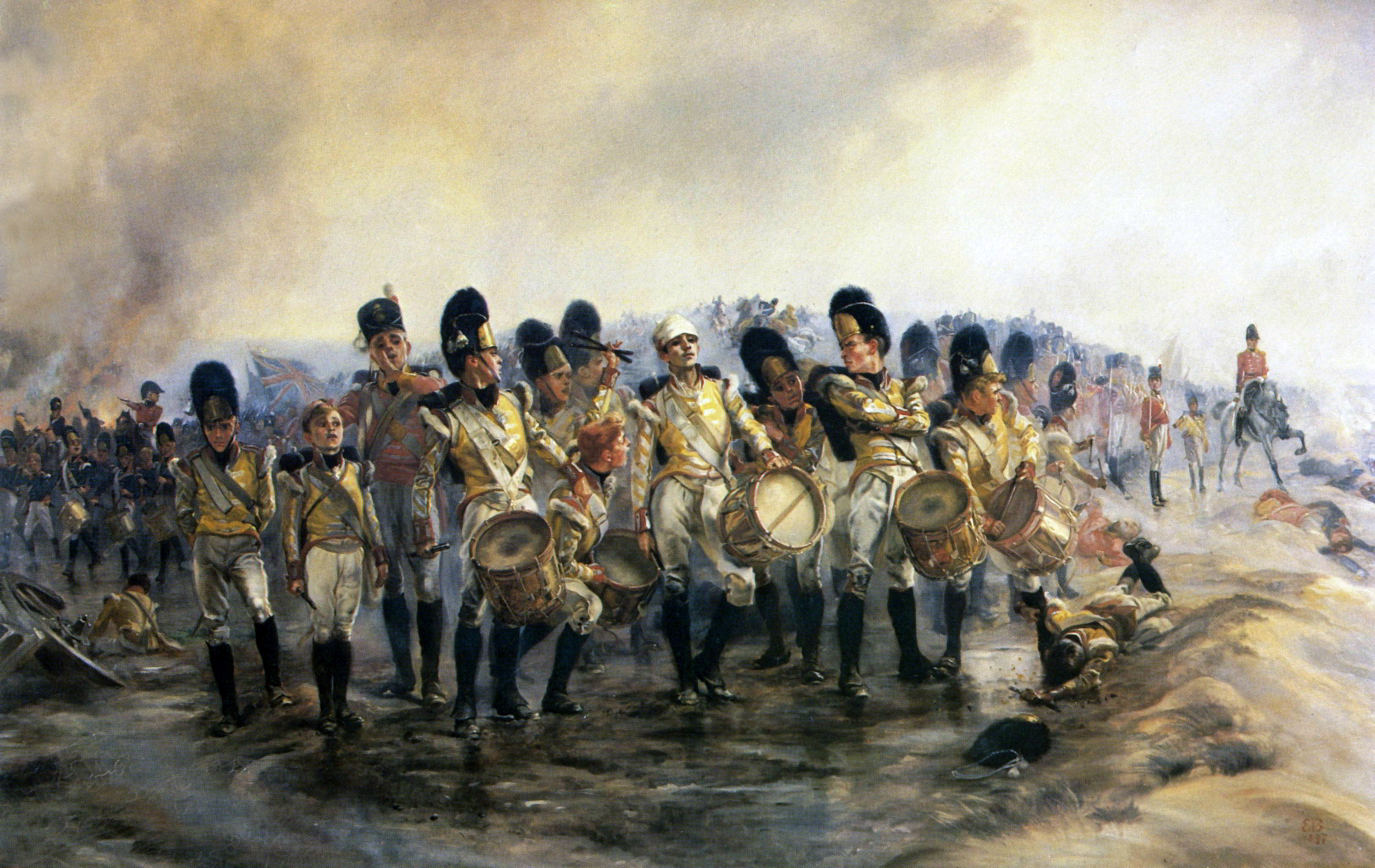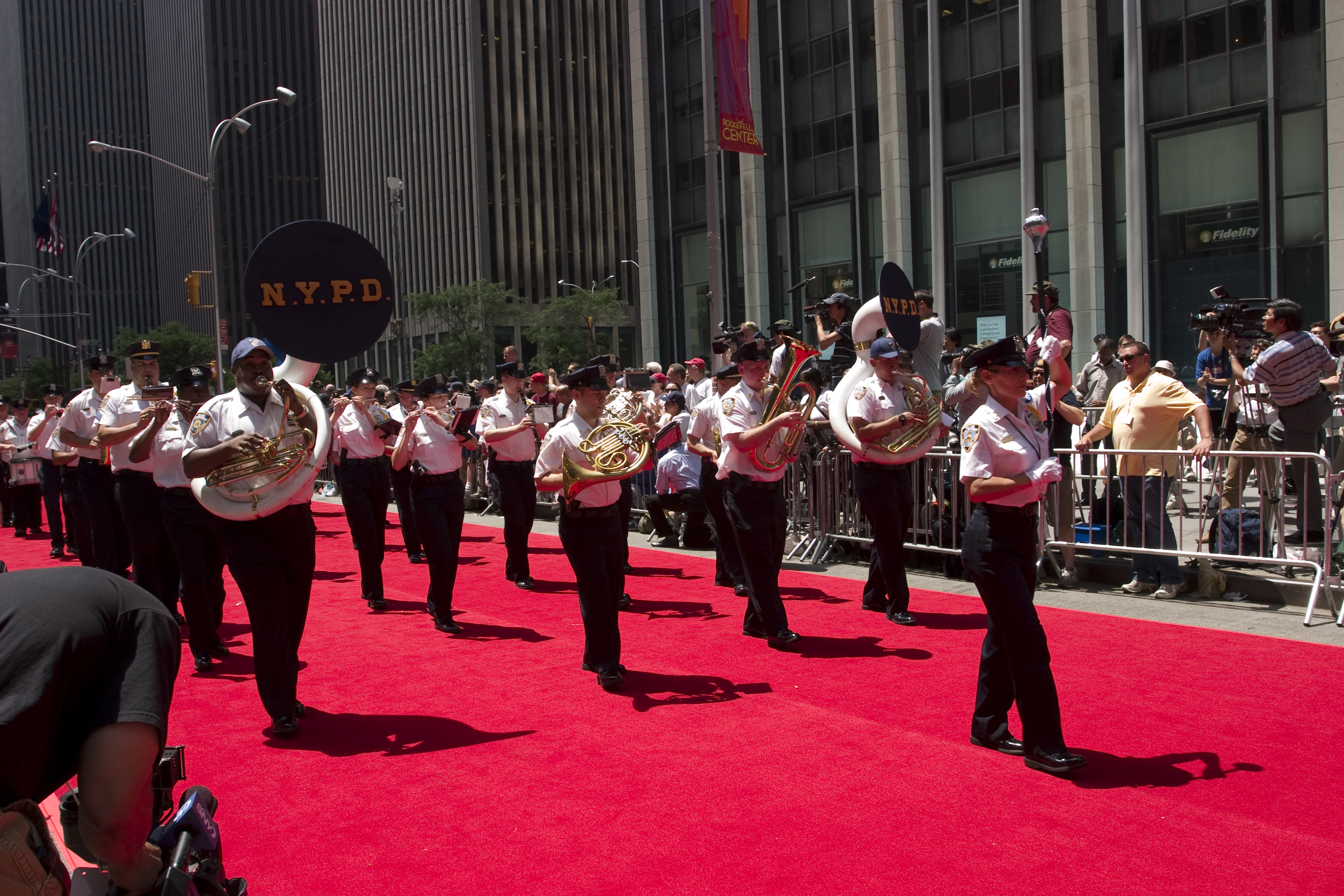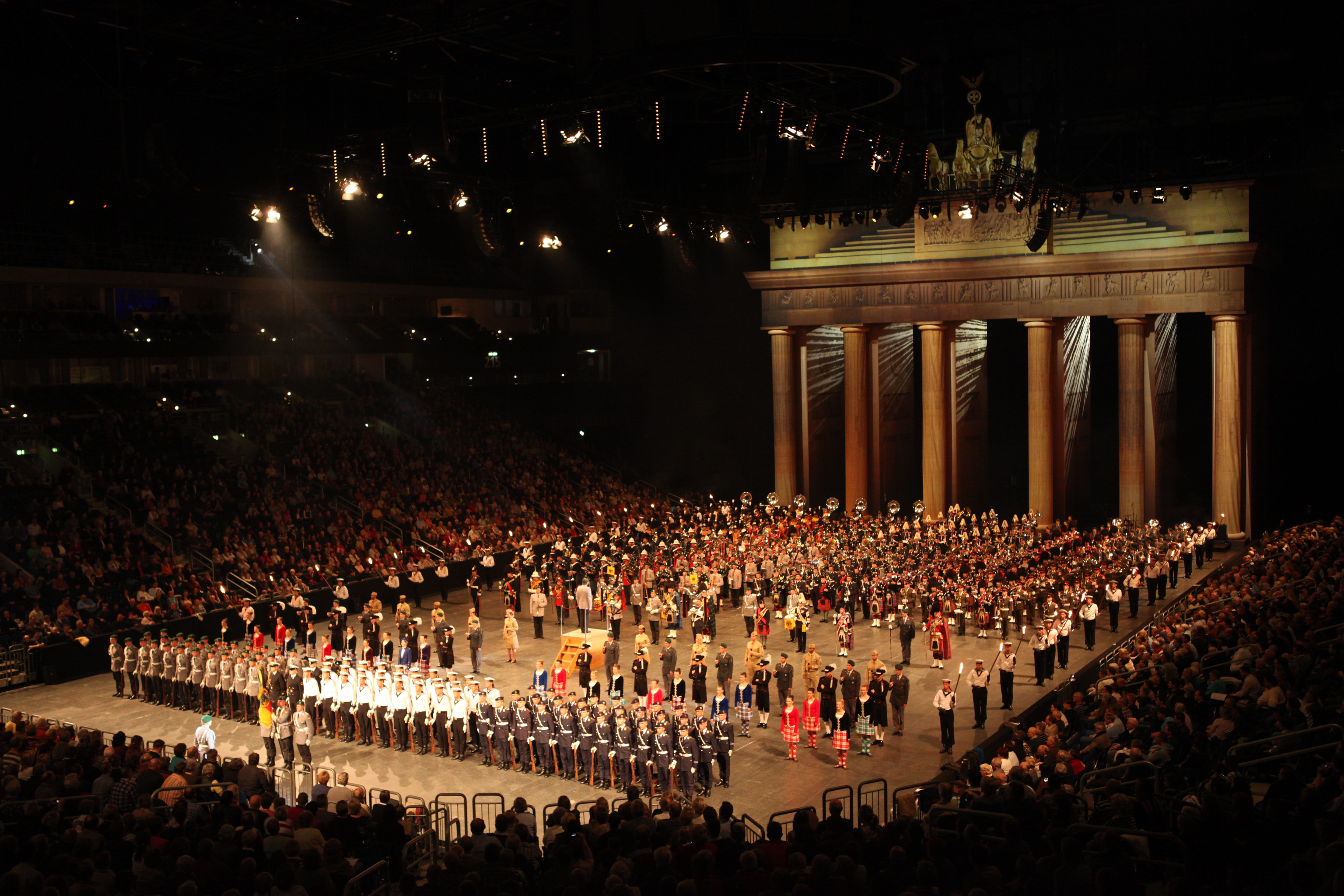|
Tenor Drums
A tenor drum is a membranophone without a snare. There are several types of tenor drums. Early music Early music tenor drums, or long drums, are cylindrical membranophone without snare used in Medieval, Renaissance and Baroque music. They consist in of a cylinder of wood, covered with skin heads on both ends, that are tensioned by ropes. Played with two sticks, this type of drum varies in pitch, according to its size. Orchestral music In a symphony orchestra's percussion section, a tenor drum is a low-pitched drum, similar in size to a field snare, but without snares and played with soft mallets or hard sticks. It is larger in diameter than depth, and tonally is midway between the bass drum and unsnared side drum. Berlioz scored for 2 tenor drums in the "Grande messe des morts". His "Te Deum" requires 6 tenor drums. Wagner wrote for this drum in "Rienzi", "Lohengrin", "Die Walküre", “Götterdämmerung”, and "Parsifal". Strauss used it in "Ein Heldenleben", and Elgar in his ... [...More Info...] [...Related Items...] OR: [Wikipedia] [Google] [Baidu] |
Membranophone
A membranophone is any musical instrument which produces sound primarily by way of a vibrating stretched membrane. It is one of the four main divisions of instruments in the original Hornbostel-Sachs scheme of musical instrument classification. According to Sachs, material, shape, skin(s), skin fastening, playing positions, and manner of playing. Hornbostel-Sachs The Hornbostel-Sachs scheme of musical instrument classification divides membranophones in a numeric taxonomy based on how the sound is produced: *21: by hitting the drumskin with a hand or object (most common form, including the timpani and snare drum) *22: by pulling a knotted string attached to the drumskin (common in Indian drums, and can be considered an example of a chordophone as well) *23: by rubbing the drumskin with a hand or object (common in Irish traditional music, an example is the bodhran) *24: by modifying sounds through a vibrating membrane (unusual form, including the kazoo) Length and breadth ... [...More Info...] [...Related Items...] OR: [Wikipedia] [Google] [Baidu] |
Fightin' Texas Aggie Band
The Fightin' Texas Aggie Band (also known as the Noble Men of Kyle Field, Kyle or just the Aggie Band) is the official marching band of Texas A&M University. Composed of over 400 men and women from the school's Texas A&M University Corps of Cadets, Corps of Cadets, it is the largest military band, military marching band in the world. The band's complex straight-line marching maneuvers are performed exclusively to American march music, traditional marches. Since its inception in 1894, its members eat together, sleep in the same dormitory, dormitories, and practice up to forty hours per week on top of a full academic schedule. The Aggie Band performs at all home College football, football games, some away games, and Muster (Texas A&M University), university and Parade (military), Corps functions throughout the year. The band has also participated in inauguration parades for many President of the United States, United States Presidents and Governor of Texas, Texas Governors, Macy's T ... [...More Info...] [...Related Items...] OR: [Wikipedia] [Google] [Baidu] |
Fanfare Band
A fanfare band, fanfare corps, fanfare battery, fanfare team, horn and drum corps, bugle band, drum and bugle corps, or trumpet and drum band (including the German ''fanferenzug'', ''fanfarenkorps'' and ''regimentsblaserkorps'', the Dutch ''drumband'', ''tamboerkorps'', ''trompetterkorps'', ''halvemaanblazerskorps'', ''klaroenblazerskorps'' and ''jachthoornkorps'', the Turkish ''boru trampet takimi'', the French ''batterie-fanfare'' and ''fanfare de cavalerie'', the Spanish ''Banda de guerra/banda marcial/banda marcial tradicional/banda ritimica/banda de guerra de trompetas/clarines'', the Portuguese ''fanfarra'' and ''banda fanfarra/banda fanfarra simples'' and the Italian ''tamburini e trombettieri'' and ''batteria tamburi'') is a military or civilian musical ensemble composed of percussion instruments, bugles, natural horns and natural trumpets (and sometimes even brass instruments). Fanfare bands are the descendants of the old medieval trumpet and drum teams that sounded fanfare ... [...More Info...] [...Related Items...] OR: [Wikipedia] [Google] [Baidu] |
Drum And Bugle Corps (classic)
Classic (or "Golden Age") drum and bugle corps are musical ensembles that descended from military bugle and drum units returning from World War I and succeeding wars. Traditionally, drum and bugle corps served as signaling units as early as before the American Civil War, with these signaling units having descended in some fashion from ancient drum and fife corps. With the advent of the radio, bugle signaling units became obsolete and surplus equipment was sold to veteran organizations (such as the Veterans of Foreign Wars and American Legion, two major organizers for classic drum corps). These organizations formed drum and bugle corps of civilians and veterans, and the corps performed in community events and local celebrations. Over time, rivalries between corps emerged and the competitive drum and bugle corps circuit evolved. The term "classic" is used for the purposes of this article to differentiate it from modern drum and bugle corps, using the time period of the establishme ... [...More Info...] [...Related Items...] OR: [Wikipedia] [Google] [Baidu] |
Corps Of Drums
A Corps of Drums, also sometimes known as a Fife and Drum Corps, Fifes and Drums or simply Drums is a unit of several national armies. Drummers were originally established in European armies to act as signallers. The major historical distinction between a military band and a corps of drums, was that 'drummers' were not employed to play their instruments to entertain or delight, but rather they carried out a utilitarian battlefield role. This role was fulfilled by trumpeters or buglers in the cavalry and the artillery, who did not form into comparative formed bodies in the way that drummers did; therefore, an orthodox corps of drums will exist in the infantry arm. History Instruments, particularly drums, have been used on battlefields as signalling devices since time immemorial across many different cultures. Most fife and drum traditions trace back to the Swiss mercenaries of the early Renaissance, and it is known that by the early 16th century, each company of infantry ... [...More Info...] [...Related Items...] OR: [Wikipedia] [Google] [Baidu] |
Marching Band
A marching band is a group of instrumental musicians who perform while marching, often for entertainment or competition. Instrumentation typically includes brass, woodwind, and percussion instruments. Most marching bands wear a uniform, often of a military-style, that includes an associated organization's colors, name or symbol. Most high school marching bands, and some college marching bands, are accompanied by a color guard, a group of performers who add a visual interpretation to the music through the use of props, most often flags, rifles, and sabres. Marching bands are generally categorized by function, size, age, instrumentation, marching style, and type of show they perform. In addition to traditional parade performances, many marching bands also perform field shows at sporting events and marching band competitions. Increasingly, marching bands perform indoor concerts that implement many songs, traditions, and flair from outside performances. In some cases, at higher ... [...More Info...] [...Related Items...] OR: [Wikipedia] [Google] [Baidu] |
Police Band (music)
A police band is a military-style band operated or sponsored by a police force. Police bands provide ceremonial support for civic events, and perform at police observances such as funerals and police academy graduations. Most police bands consists exclusively of professional police officers, while others consist of personnel of law enforcement and other special agencies. Like military bands, their repertoire is mostly composed of ceremonial marching music and honors music (national anthems and fanfares). History The earliest instance of a police band was the Glasgow Police Pipe Band, originally called the Burgh of Govan Police Pipe Band, which was formed in Glasgow, Scotland in 1883, and was soon followed by a similar organization formed in Edinburgh. The first-organized police band in Australia was that of the Grayville Police Band, which was established in 1884. Thirteen years later, in 1897, the Milwaukee Police Band became the first such ensemble to be formed in the United ... [...More Info...] [...Related Items...] OR: [Wikipedia] [Google] [Baidu] |
Military Bands
A military band is a group of personnel that performs musical duties for military functions, usually for the armed forces. A typical military band consists mostly of wind and percussion instruments. The conductor of a band commonly bears the title of Bandmaster or Director of Music. Ottoman military bands are thought to be the oldest variety of military marching bands in the world, dating from the 13th century. The military band is capable of playing ceremonial and marching music, including the national anthems and patriotic songs of not only their own nation but others as well, both while stationary and as a marching band. Military bands also play a part in military funeral ceremonies. There are two types of historical traditions in military bands. The first is military field music. This type of music includes bugles (or other natural instruments such as natural trumpets or natural horns), bagpipes, or fifes and almost always drums. This type of music was used to control troo ... [...More Info...] [...Related Items...] OR: [Wikipedia] [Google] [Baidu] |
2009 Tenordrumming
9 (nine) is the natural number following and preceding . Evolution of the Arabic digit In the beginning, various Indians wrote a digit 9 similar in shape to the modern closing question mark without the bottom dot. The Kshatrapa, Andhra and Gupta started curving the bottom vertical line coming up with a -look-alike. The Nagari continued the bottom stroke to make a circle and enclose the 3-look-alike, in much the same way that the sign @ encircles a lowercase ''a''. As time went on, the enclosing circle became bigger and its line continued beyond the circle downwards, as the 3-look-alike became smaller. Soon, all that was left of the 3-look-alike was a squiggle. The Arabs simply connected that squiggle to the downward stroke at the middle and subsequent European change was purely cosmetic. While the shape of the glyph for the digit 9 has an ascender in most modern typefaces, in typefaces with text figures the character usually has a descender, as, for example, in . The mod ... [...More Info...] [...Related Items...] OR: [Wikipedia] [Google] [Baidu] |
Timpani
Timpani (; ) or kettledrums (also informally called timps) are musical instruments in the percussion family. A type of drum categorised as a hemispherical drum, they consist of a membrane called a head stretched over a large bowl traditionally made of copper. Thus timpani are an example of kettle drums, also known as vessel drums and semispherical drums, whose body is similar to a section of a sphere whose cut conforms the head. Most modern timpani are ''pedal timpani'' and can be tuned quickly and accurately to specific pitches by skilled players through the use of a movable foot-pedal. They are played by striking the head with a specialized drum stick called a ''timpani stick'' or ''timpani mallet''. Timpani evolved from military drums to become a staple of the classical orchestra by the last third of the 18th century. Today, they are used in many types of ensembles, including concert bands, marching bands, orchestras, and even in some rock bands. ''Timpani'' is an Italian ... [...More Info...] [...Related Items...] OR: [Wikipedia] [Google] [Baidu] |
Matched Grip
In percussion, grip refers to the manner in which the player holds the percussion mallet or mallets, whether drum sticks or other mallets. For some instruments, such as triangles and large gongs, only one mallet or beater is normally used, held either in one hand or in both hands for larger beaters. For others, such as snare drums, two beaters are often used, one in each hand. More rarely, more than one beater may be held in one hand; for example, when four mallets are used on a vibraphone, or when a kit drummer performs a cymbal roll by holding two soft sticks in one hand while keeping a rhythm with the other. Matched or unmatched When two identical beaters are used, one in each hand, there are two main varieties of grip: * Unmatched grips, known as traditional grips because of their association with traditional snare drum and drum kit playing, in which the right and left hands grip the beaters in different ways, often one underhand and one overhand. * Matched grips in wh ... [...More Info...] [...Related Items...] OR: [Wikipedia] [Google] [Baidu] |


.jpg)






